The Flowers of Evil: Complete Series
[Note: This is a rare spoiler-heavy review. I talk explicitly about how Oshimi ends the series and offer my interpretation. If you want a review that leaves the mysteries and plotpoints alone, check out my review of the series' first five volumes.]
In one of Shūzō Oshimi's final chapters in Flowers of Evil, former Baudelaire fanatic Kasuga is assigned to read once more from the poet's Les Fleur du mal. The poem is "The Head of Hair" (also known in English as "Her Hair"), a devotion to luxuriating voyeuristically in a particular woman's thick, dark hair. By calling to mind "sweltering Africa" and "languorous Asia," the verses evoke a sense of finding the exotic in the mundane, of being rapturously transported by conveyance of the immediate and physical presence of another.
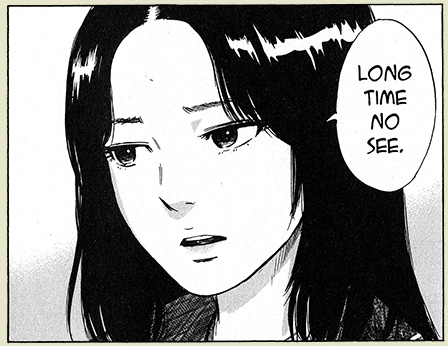
It's been a twisted and twisting road for Oshimi's series as well as for his characters. When I reviewed the first five volumes two years ago (a review I recommend as an essential complement to this one), the series seemed to be headed toward an immediate crescendo—and in a way, it was. The tension and perversion builds throughout volume 6 and climaxes in the first chapter of volume 7. It's cataclysmic to the lives of the series' characters, and its effects mark everyone for the remainder of the story.
With the second chapter of volume 7, however, everything changes.11...when the Fire Nation attacked! The narrative's tone is markedly altered. None of the overt tensions or perversions remain. Kasuga's world has gone colourless and mundane. He's a subdued wallflower in his new highschool, hesitantly going along with wherever his social circle's current pulls him. By volume 6 he's destroyed his copy of Baudelaire, signifying either a culmination or a new direction (we're pressed to wait and see to discern which is the case); but by volume 7, Kasuga has given up entirely on reading. He's nearly a blank slate. He seems rudderless, and less patient readers will suspect the same of the series.
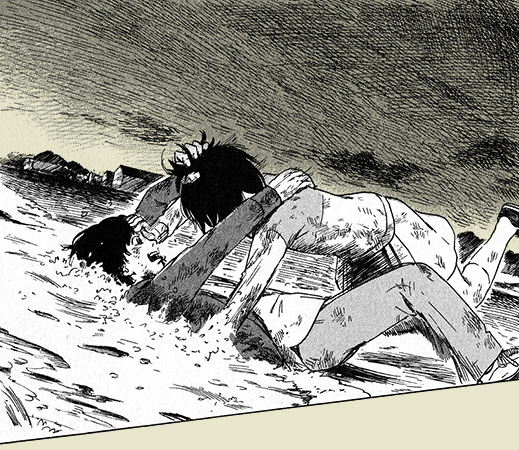
As the third major arc of the story set in, readers discussing the series were concerned that Oshimi had lost steam and direction. It's not uncommon that a story's popularity will extend its publication beyond the point that its narrative can reasonably sustain.22 An immediate example is Death Note, a series positively swollen with tension through its first five volumes. The creators had originally intended to wrap with that climax, but the wild popularity of the series caused publishers to push them to extend the story for twice the length intended. And while the second half undulates beneath the seas of Goodness and Acceptability, those are so far and distinct from the pure greatness of what came before that most readers feel cheated by the introduction of the new characters, Near and Mello. But while Oshimi moves Flowers of Evil in drastically different directions, the new vector actually presents a kind of salvation for a narrative that had gone so far off the rails that it likely couldn't have recovered without some compelling rearrangement of the furniture. So it is that with his new direction, Oshimi is given the rug with which to really pull the room together.
My wife rather loathed Flowers of Evil, at least at first. She read the first five volumes in order to help me get a handle on the book for my previous review. She was repulsed. The repellent nature of the kids' depravities gave a feeling of nauseated horror. I talked somewhat about how unsettling the books could be in my review. It wasn't the easiest sell to get her to read the rest of the series, but I wanted someone to bounce ideas off. In the end, she felt the books redeemed themselves and ended up glad she had finished entire series. I felt the same. This was an exciting series to encounter. There's a lot here, much food for much thought.
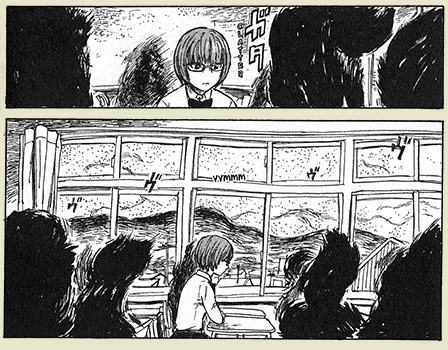
One of the essential elements of discussion throughout Flowers of Evil, from beginning to end, is the nature and necessity of perversion. Characters' interaction with the perverse, whether to embrace it or to demur, is at the heart of their futures—whether they with be able to transverse the mountains walling their pubescent selves off from the broad wide and exotic world that seems to only exist in their dreams and visions. Without the drive to perversion, these kids will be trapped in their stultifying provincial lives. But taking on the mantle of pervert creates a window into a whole new world of opportunities. This is a lodestone given from the series' beginning, but the nature of what exactly is perversion is a question that Oshimi elides until his finale.
In the first two arcs (culminating in the first chapter of volume 7), Kasuga and Nakamura's quest for the perverse manifests as mere dilettantism. They steal intimate articles of clothing, they display those articles, they wreck a school room, they run away, they cause a touch of social mayhem, they talk back to authority figures, and they attempt self-immolation. Essentially, they act out in the ineffectual manner that the voiceless often do (I mean, minus the panty-thefts),33This is not meant as a judgment against the voiceless but more as a comment on the inherently mute nature of voicelessness. and the wider culture has no mechanism by which to hear (let alone comprehend) their anguish. Throughout these arcs, Kasuga struggles to understand perversion. He recognizes its necessity, but cannot get his hands around what all it entails. He sees perversion as the means to saving and protecting Nakamura (in his terms, allowing her to get to the other side), but his inability to ascertain what perversion actually means in their context consigns Nakamura to destruction (fortunately abortive).
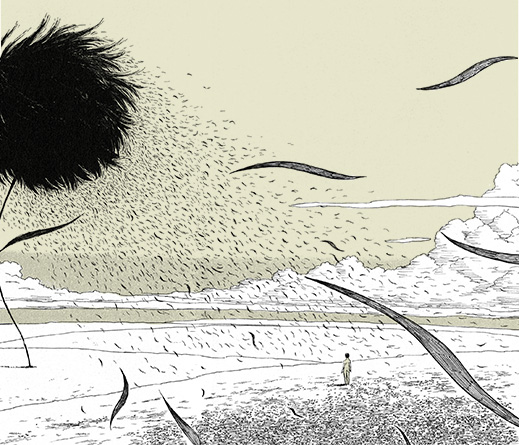
With the rise of the third act, Kasuga isn't any closer to discovering the nature of perversion, but the need to understand has moved from immediate to remote. He has no contact with Nakamura and is alone in a new context at first very different from his prior secluded rural community. He's largely content only to exist until he's occasionally reminded of Nakamura. After one such reminder shocks him into remembering his earlier raison d'etre, Kasuga plaintively broaches the subject with some thuggish types:
Here I am, still alive. Breathing my pathetic breaths when there's no reason. How ought I to go on living? How do I live as shamelessly as you guys do?
It's unlikely that Kasuga actually suspects these toughs of holding any of the keys to his reawakening dilemma, but he's still got a taste for self-destruction and the moment does catalyze his renewed need to understand perversion. To underscore the rebirth of his quest and emphasize the new direction it will chart, he moments later encounters a kind of surrogate for Nakamura in the form of Tokiwa—and in a fit of contrivance, Oshimi has her looking at Baudelaire's Fleur du mal. Tokiwa is several times referenced as bearing a resemblance to Nakamura, though for the most part the comparison seems only glancingly justified by a miniscule physical likeness. Regardless, Kasuga's growing friendship with Tokiwa gives him a constant reminder of the desire to understand his suspicion that perversion is necessary to a true life. This continued interest in the flowers of evil (the series emblem for the Perverse) gives the series a connection with the prior two acts—even while the governing narrative is remarkably more subdued.

Kasuga is growing up and Oshimi's Flowers of Evil is obvious bildungsroman, being dedicated "to all the boys and girls suffering the torment of puberty, and to all the boys and girls who have ever suffered the torments of puberty." In my previous review of the series, I remarked at length on the kind of wild expression against the ragged inequities of the world as the young teen encounters it. In this third arc, Kasuga (no longer in junior high) has largely put aside that overt kind of rebellion against his society and begins exploring the garden of earthly delights available to the regular citizen in contemporary Japanese society—all in his own broken and awkward manner, of course. In eventually coming to pursue a relationship with Tokiwa, he struggles to maintain the sense of a peaceful life while simultaneously still investigating his unanswered questions. Even his relationship with Tokiwa is in some degree an attempt to discover the end to which he is destined. Kasuga encourages Tokiwa to write and finish her novel because he recognizes it as being his own story and needs some sense of where it will all end for himself. He needs to know that there's some hope that his quest will be completed.
When Saeki reappears, Kasuga's precarious plans begin to sputter. He had tried to play the straight and had looked for satisfaction in subsuming his perverse side, but Saeki (made bitter by their junior high disasters) unravels that with a simple, surgical question: Will you make her unhappy too? (Said with a smile that says she knows Kasuga in some ways better than he does himself.) This instigates a confrontation with the spectre of Baudelaire's flower in which Kasuga's fears are addressed and he comes to recognize that before he can settle his account and complete his growth, he needs to understand why Nakamura denied him participation in what was to be their final act of perversion. In a kind of vision-moment he crushes Baudelaire's flower, a signification that his quest for perversion will remain on hold until he understands Nakamura.
Kasuga underscores his new mindset by pursuing a safe, comfortable, non-perverse relationship, but he's torn by a conflict. He hopes to find his answers through Tokiwa, but simultaneously he knows he needs resolution with Nakamura. He spends some salad days, playing the pleasant young man next to Tokiwa's industrious, eager-to-please burgeoning young novelist, but we find the crushed flower has left a remnant stain in his palm and soon its tendriling petals begin to assert themselves. Kasuga's realization that he cannot fully escape his path without first dealing with it prompts him to return to his old town, where he encounters both death (of a relative) and a means to resolving his quest (the location of the long-absent Nakamura).
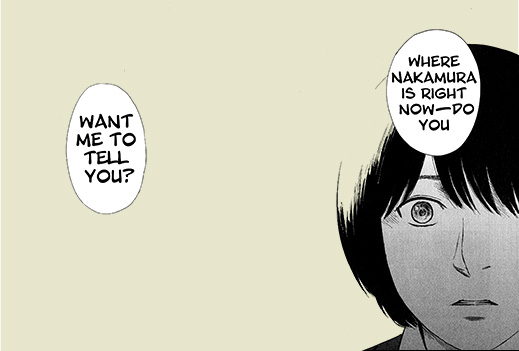
This revelation prompts a total confession to Tokiwa (who could previously only guess at Kasuga's past) and through some tumult prompts the couple to confront Nakamura. In a sense, Oshimi lets Kasuga have his cake and eat it too. Tokiwa, initially pissed and bereft, becomes the active instigator in Kasuga's resolution with Nakamura. Almost from beginning to end, their reunion is Tokiwa's show, emphasizing just how essential she will be to Kasuga's solution going forward. In a final, ecstatic culmination to Kasuga's confrontation with Nakamura,44After a four-page spread that may be my favourite bit of the entire series. Nakamura reiterates—this time verbally—her reason for pushing Kasuga off the stage at the end of the second story arc. "Don't ever come back. You normal-man." Nakamura releases Kasuga from his quest to solve her by suggesting that he was never going to be able to have the brand of perversity she'd require. It's not the end of his quest, but it's a step. It gives him time to consider and removes the immediacy of what he perceived as a threat to Nakamura. Even though she's clearly not All Well, she's not in any present danger.
So we in the penultimate chapter catch up with Kasuga in college. He's reading Baudelaire again, but as an assignment. He's not suffering from any of the obsessiveness of youth. His relationship with Tokiwa remains sturdy. She continues writing and studying and he, still a bit rudderless, ponders the spectral blank canvas of a composition book. In a post-coital reverie, Kasuga dreams mundane, pleasant, happy, normal futures for all the principal characters who've expressed their deep brokeness throughout the series. Kasuga and Tokiwa are together with children. Saeki is happily married. Kinoshita, who was bereft at being left behind and unable to escape the mountains, is visited by former best friend Saeki. And Nakamura is well-adjusted and is happily reacquainted with the father who saved her from self-immolation back in junior high.
The curiosity that marks this dream as something Of Import is that it is presaged by Kasuga, standing naked and stripped bare before the reborn Flower of Evil, with one of its tendril-petals brushing his chest right where Nakamura tore at him years earlier. This marks, I believe, the following scenes as the ultimate perversion. If one considers how junior high Kasuga and Nakamura would react to Kasuga's dream, we recognize that Kasuga has reached his ultimate understanding of perversion. If the "acting out" of the junior high years is a dilettante's version of perversion, then the adult's version is the acquiescence of social normalization—though not with doe-eyed acceptance but as a visceral considered response to the bald inequity of the world. Kasuga dreams the life of the true pervert and wakes to make that a reality so far as his power will allow.
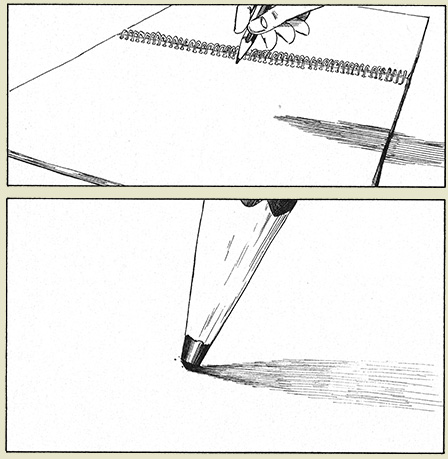
The first act of the rest of his life after receiving this moment of enlightenment is to open up his composition book and write. And what he writes is a single tendril-petal. This moment is anthemic for him. This is what defines him moving forward. He, like Baudelaire, will find the exotic in the mundane. He will be rapturously transported by his proximity to living the normal, pleasant life with Tokiwa. And perhaps most perverse, he will make this happen for Nakamura as well—if not in reality then at least in the province of fiction.
The final chapter of Oshimi's story requires a bit of effort to interpret, but works best when understood as the first chapter of Kasuga's new novel, the continuation of what he writes after drawing that evil petal at the close of the dream chapter. In his dream, Kasuga feverishly writes the futures of all his friends, page after page, a tremendous sprawling manuscript. When he wakes, Kasuga takes up this task for real. And in Flowers of Evil's final chapter, we see Kasuga write Nakamura's history, placing himself in the story as saviour. Everyone involved is perverse save for Nakamura and eventually, we see, Kasuga. Nakamura is threatened to be swallowed by the perversion but Kasuaga offers her salvation. Nakamura doesn't know it at the time, but this is the very salvation Kasuga dreams for her in the prior chapter.
His perversion is complete. Perversion and normalcy blend and mix and become indistinguishable but for the motive on which they are founded.
The last couple years of following Oshimi's wild trail have been envigourating. Flowers of Evil takes a couple fascinating turns and keeps readers on their toes wondering what will happen next. And while early on I was uncertain of just how much I would enjoy the book, in the end it was just a really cool exploration of growing up. Oshimi's page design is always solid and his art generally avoids the hiccoughs of the earlier chapters (save for the continuing recurrance of characters with the odd oversized antihelix). If it weren't for the unwieldy length at eleven volumes, I'd suggest that Flowers of Evil would make the perfect book club book, as it's ripe for discussion.
Good Ok Bad features reviews of comics, graphic novels, manga, et cetera using a rare and auspicious three-star rating system. Point systems are notoriously fiddly, so here it's been pared down to three simple possibilities:
3 Stars = Good
2 Stars = Ok
1 Star = Bad
I am Seth T. Hahne and these are my reviews.
Browse Reviews By
Other Features
- Best Books of the Year:
- Top 50 of 2024
- Top 50 of 2023
- Top 100 of 2020-22
- Top 75 of 2019
- Top 50 of 2018
- Top 75 of 2017
- Top 75 of 2016
- Top 75 of 2015
- Top 75 of 2014
- Top 35 of 2013
- Top 25 of 2012
- Top 10 of 2011
- Popular Sections:
- All-Time Top 500
- All the Boardgames I've Played
- All the Anime Series I've Seen
- All the Animated Films I've Seen
- Top 75 by Female Creators
- Kids Recommendations
- What I Read: A Reading Log
- Other Features:
- Bookclub Study Guides










